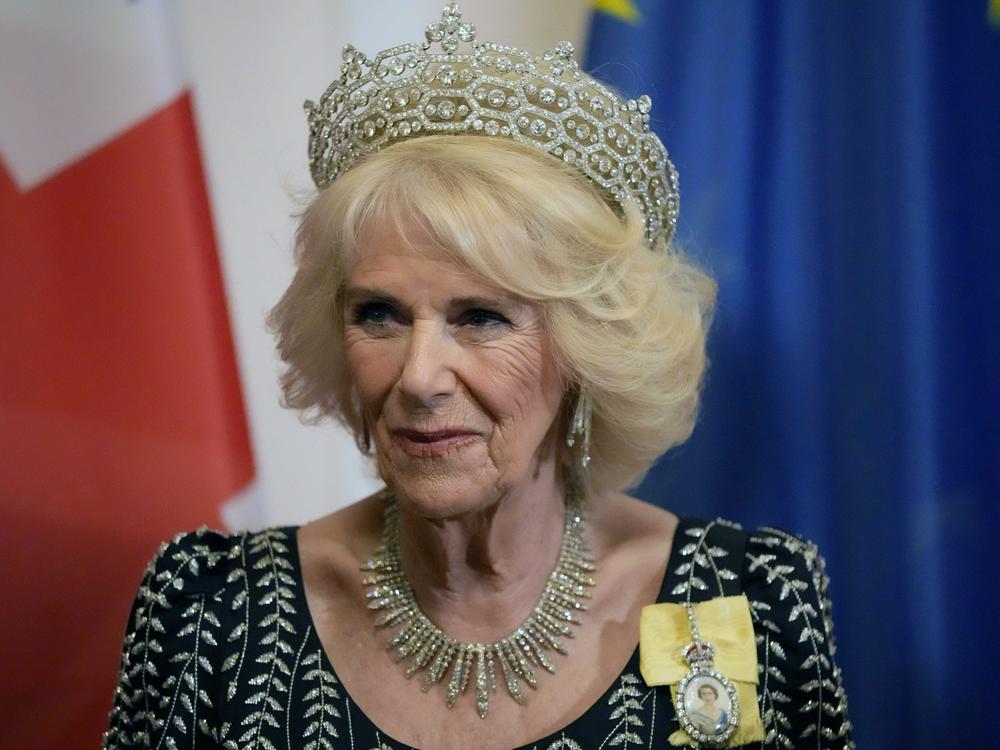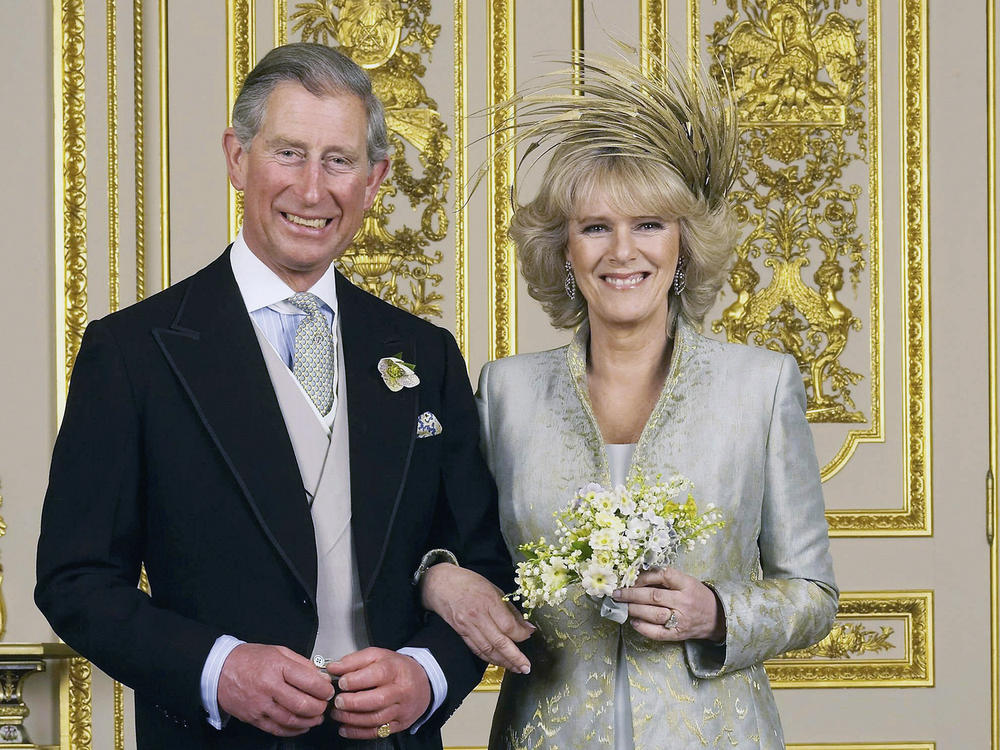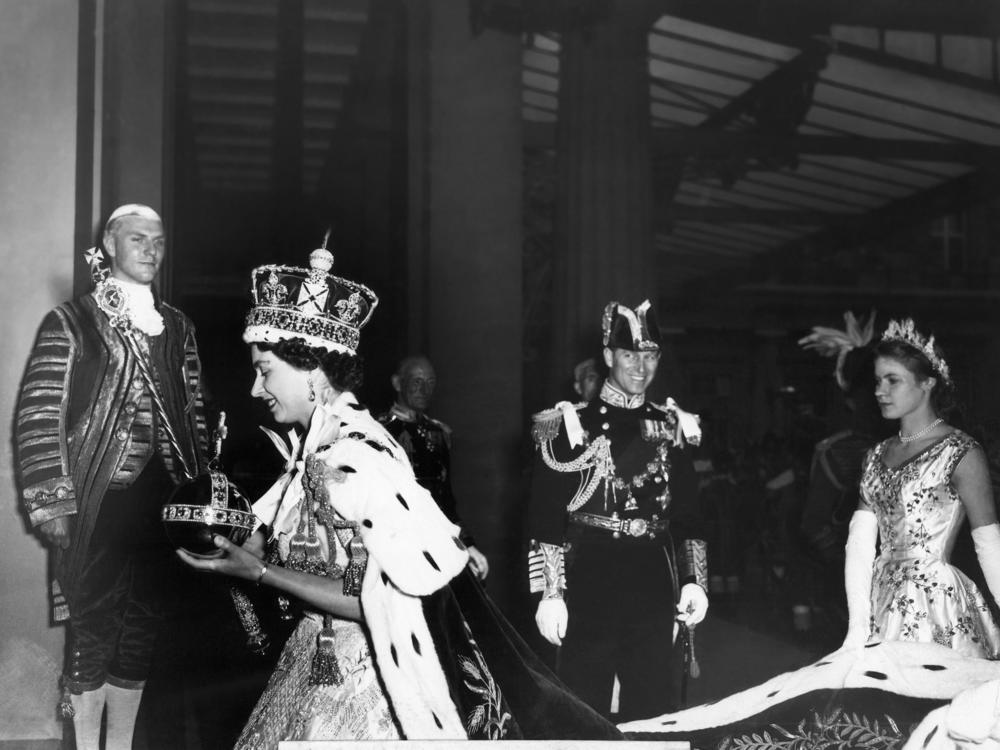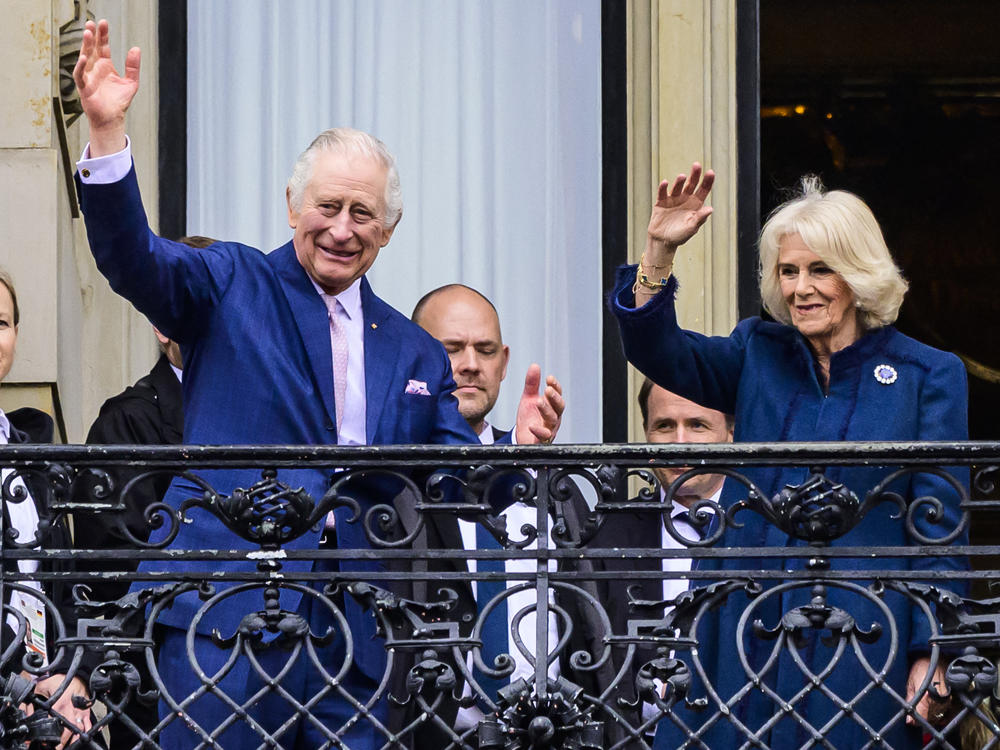Section Branding
Header Content
The royals dropped 'consort' from Queen Camilla's title. What's the big deal?
Primary Content
Updated April 6, 2023 at 3:08 PM ET
Buckingham Palace released King Charles' coronation invitation on Tuesday, giving royal watchers much to discuss.
The invitation, printed on recycled cards with gold foil detailing, features symbolic flora, fauna and coats of arms. It will be sent to over 2,000 guests inviting them to the May 6th event at Westminster Abbey (where first lady Jill Biden will represent the U.S.).
And it refers to the king's wife as "Queen Camilla" for the first time, officially dropping the word "consort" from her title.
That's raised some eyebrows, in large part because of Camilla and Charles' controversial relationship and the palace's previous stance on her position (more on all that below).
"Like everyone else, I was surprised to see Camilla announced as Queen Camilla, as opposed to Queen Consort Camilla, which Queen Elizabeth had indicated was how she expected Camilla to be addressed once she became the monarch," says Nicoletta Gullace, an associate professor of British history at the University of New Hampshire.
The palace argued it made sense to call Camilla "queen consort" before Queen Elizabeth died to more clearly distinguish between the two, Gullace tells NPR. However, she adds, this invitation confirms that won't be the case going forward.
"It's mostly symbolic, but when you think about it, the monarchy itself is mostly symbolic," Gullace says, noting that titles have long been a point of contention for the family of Prince Harry and Meghan, for example. "So these symbolics end up being very important."
So what does this change actually mean, and why is it causing such a stir?
First, some context on the royal marriage
Camilla's royal upgrade has been awaited and debated by some for as long as she's been married to Charles.
Charles and Camilla knew each other before he married Diana in 1981, and they continued their relationship beyond then. Princess Diana famously said "there were three of us in this marriage," and many of her admirers have blamed Camilla for breaking it up.
"Even though Diana died in 1997 and Charles and Camilla have been married since 2005, the legacy of Diana is something that still curses Camilla," says Gullace.
After Charles and Camilla got married, many wondered whether the mistress-turned-duchess could be a future queen. At the time, royal agreement stipulated that she would eventually be known as "princess consort" instead.
But Camilla's approval ratings have steadily increased over the years, with many Britons seeing her as a warm presence and a calming influence on her husband. And she's gradually taken on a more public role with her royal duties, including charity work focused on empowering women and promoting literacy.
In 2021, Queen Elizabeth appointed Camilla a "Royal Lady of the Most Noble Order of the Garter," the most senior order of knighthood in the British honors system.
And the following year, on the eve of her 70th anniversary on the throne, she said it was her "sincere wish" that Camilla be known as queen consort "when the time comes." Camilla went on to adopt that title after Queen Elizabeth's death in September 2022.
Gullace says the "consort" label seemed to symbolize all of the things that made Camilla seem illegitimate in the eyes of the public and the royal family, including the fact she was divorced.
"And [Charles'] insistence on removing it is really an attempt to move forward and to assert his legitimacy and hers in the face of all the different criticisms they have had," she adds. "So I do think it is actually a fairly significant thing that happened, the dropping of that word, and I think that is why it has gotten a fair amount of attention."
Now for some light semantics
There are actually several different types of queens in U.K. history, depending on their ancestry and marital status (for example, queen dowager and queen mother).
"Queen regnant" refers to a reigning female monarch, equivalent in rank and title to a king. That would be Queen Elizabeth II.
"Queen consort," on the other hand, refers to the wife of a reigning king. She still holds the title and the crown, but doesn't have the same political or military powers as a king. This describes Camilla, who will be crowned alongside Charles at the ceremony.
"Consort" means you're a monarch, but not entitled to rule, says Gullace. And it applies to men too.
"So Prince Philip and male spouses of reigning queens are called 'prince consort' because nobody wants to create any confusion of who is in the seat of power," she says, explaining that kings "generally take precedence over queens."
But "consort" isn't really part of the title, says librarian and royal historian Marlene Koenig. She tells NPR she's not surprised that it wasn't on the invitation.
She looked up how former queen consorts, such as Alexandra, Mary and Elizabeth (the late queen's mother), were styled after their husbands became king, and says she "very rarely" saw the word consort. That was usually only in formal settings like the queen's coronation service or prayers.
Within weeks, she said, most mentions of those queens, including in news coverage, called them just that. For instance, the 1937 coronation invitation for King George VI said "King George VI and Queen Elizabeth."
In a word, it's about the future
The discourse over the title change is arguably a window into a larger conversation about the future of the monarchy itself.
Koening describes the change as the last step in a gradual process of undoing the stipulations the palace put on Camilla at the time of her marriage to Charles.
"I call it a slow burn, that it will be righted when the coronation [takes] place," she adds.
Meanwhile, Gullace frames it as a step forward.
"So already, allowing Charles to be king while divorced himself and married to a divorced woman is a sign of tremendous change, the removal of the word consort legitimating that is really a highly modern gesture that conforms much more realistically to modern marriage practices and to the king's new role," Gullace says.
After decades of preparation, King Charles, 74, is reportedly focused on modernizing and "slimming down" the monarchy. He's long been passionate about philanthropic causes, particularly environmental ones, and many Brits are waiting to see what that means for his reign.
Gullace says Camilla has a difficult job, too — noting that while people seem pleased with how she's performing her royal duties and supporting her husband, she's also been accused by Prince Harry of "working behind the throne to cast bad publicity on her stepsons."
Above all, Gullace says, the biggest unknown is how the monarchy will fare without Queen Elizabeth, who reigned over seven turbulent decades and "had something special about her."
It remains to be seen whether Charles and Camilla have it too, she says, and how that might influence public opinion about the institution itself, which is already low among younger generations.
"So I think that is going to be the big question that we're left with," she says. "We'll see how well the coronation is received, how widely watched it is, and how Charles's monarchy fares after that."
Copyright 2023 NPR. To see more, visit https://www.npr.org.
Correction
An earlier version of this story incorrectly referred to Elizabeth I as a queen consort, instead of Queen Elizabeth The Queen Mother.




